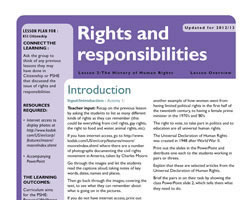New to Safeguarding Essentials?
Subscribe Now
|
Existing members
Sign in
here
Citizenship Lesson Plans / KS3 - Rights and Responsibilities - 4 lessons / Rights and Responsibilities Lesson Plan 2 - History of Human Rights
There are 2 Documents available to download for
Rights and Responsibilities Lesson Plan 2 - History of Human Rights
In this lesson students look at articles from the Universal Declaration of Human Rights and American civil rights.

- TRS Citizenship Rights Lesson 2 PDF Downloads = 60
- TRS Citizenship Rights Lesson 2 PPT Downloads = 60
Connect the Learning
Ask the group to think of any previous lessons they may have done in Citizenship or PSHE that discussed the issue of rights and responsibilities.The Big Picture
The curriculum aims for the PSHE: Personal Wellbeing programme of study include young people becoming “responsible citizens who make a positive contribution to society.” The Citizenship programme of study at KS3 requires students to learn about “…their rights, responsibilities, duties and freedoms…” The Every Child Matters aim that is most relevant here is “make a positive contribution”.
The Learning Outcomes
From the KS3 Citizenship programme of study:1.2
a. Exploring different kinds of rights and obligations and how these affect both individuals and communities.
b. Understanding that individuals, organizations and governments have responsibilities to ensure that rights are balanced, supported and protected.
c. Investigating ways in which rights can compete and conflict, and understanding that hard decisions have to be made to try and balance these.
Input/Introduction
Activity 1: Teacher input.
Recap on the previous lesson by asking the students to list as many different kinds of rights as they can remember (this could be everything from civil rights, gay rights, the right to food and water, animal rights etc).
If you have internet access, go to http://www.kodak.com/US/en/corp/features/moore/mooreIndex.shtml where there are a number of photographs documenting the civil rights movement in America, taken by Charles Moore.
Go through the images and let the students read the captions aloud, taking notes of key words, dates, names and places.

